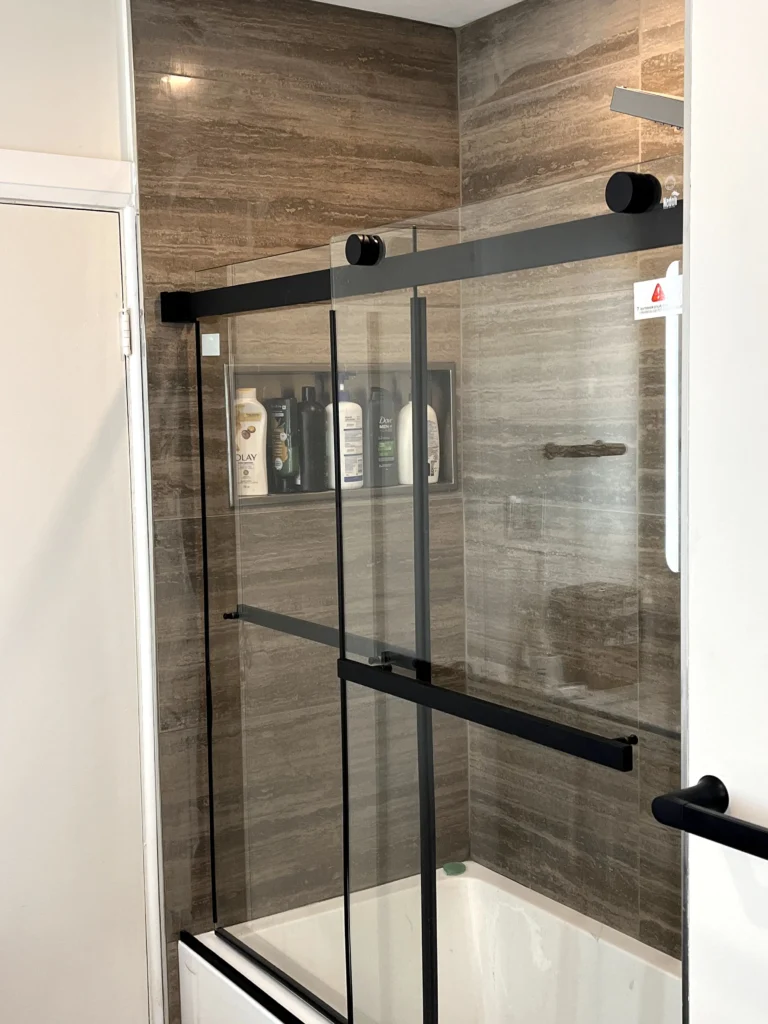Shower niche planning has quickly become one of the most important steps in modern bathroom renovations. A niche may seem like a small detail, but it can completely change the way you use and enjoy your shower. It’s where you store shampoos, razors, soaps, and personal care products — while also serving as a built-in design element. In this guide, I’ll share everything you need to know about shower niches, from sizing and styles to placement and durability, based on my experience and the best industry practices.
Why Shower Niches Matter
A shower niche is more than just storage; it’s a functional upgrade that helps keep your bathroom organized and stylish. Compared to bulky racks or corner shelves, a niche blends seamlessly into the wall. Homeowners appreciate how it eliminates clutter and provides a clean, modern look. Beyond function, a niche can also serve as a visual highlight in your tile design, giving your bathroom a custom finish. For more space-saving solutions, explore my guide on bathroom storage options.
Choosing the Right Size and Style
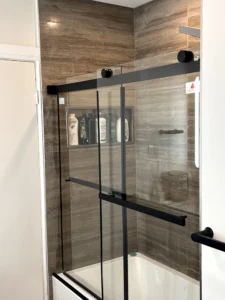
The first step in niche planning is deciding how big it needs to be. Do you want one large niche to store bottles? Or multiple smaller niches for symmetry and organization? Standard pre-made niches often come in 12×12 or 12×24 sizes, which fit most needs. For families that buy oversized pump bottles, a taller vertical niche — 14 inches or more — ensures those bottles fit without cramming. Long horizontal niches, often 24 to 36 inches wide, can hold multiple products side by side while creating a sleek, modern feel.
You can also play with combinations: one large niche for bottles and a smaller niche higher up for razors, bar soaps, or loofahs. Couples often prefer two niches for personal storage, which keeps the shower clutter-free. The style choice isn’t just about storage; it’s also about aesthetics. Do you want a statement piece that spans the width of the wall, or a more subtle inset that blends with your tiles? Both approaches can work beautifully depending on your bathroom’s design.
Custom vs. Finished Niches
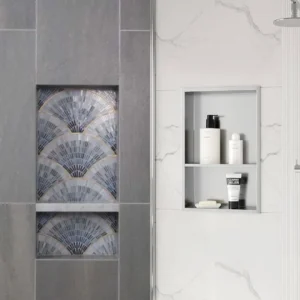
There are two main types of shower niches: custom-built and finished (or pre-manufactured).
Custom tiled niches are highly flexible because you can make them any size or shape. They can be finished to match your tile or contrast with an accent pattern. However, they do require more labor and can be prone to water infiltration over time if not properly sealed.
Finished niches, often made of stainless steel or synthetic stone, are durable, waterproof, and easy to clean. These pre-made models eliminate grout lines, which means no leaks and less maintenance. In my projects, stainless steel niches are becoming increasingly popular because they offer a sleek design and long-term reliability.
Vertical vs. Horizontal Niches
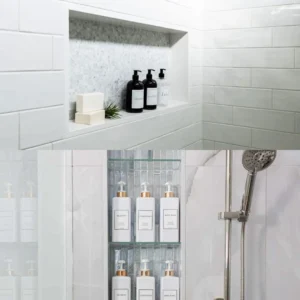
The orientation of your niche can completely change both storage and design. Vertical niches make the best use of wall height and allow for multiple shelves, perfect for razors, soaps, and bottles. They’re also cost-effective since they fit between existing wall studs. Horizontal niches provide a long ledge that can hold multiple items side by side. They look modern and elegant, but often require additional wall reinforcement, which adds to cost.
Some homeowners choose to combine the two: a horizontal niche across the main wall for bottles and one smaller vertical niche near the corner for accessories. Mixing orientations is a smart way to maximize both function and style.
Placement: Height and Positioning
Getting the placement right is crucial. In a standard shower, waist height (around 36 inches above the base) works best for reach. In a tub-shower combo, niches are placed lower for accessibility. To avoid soap scum build-up, it’s best to position niches outside the direct splash zone. This usually means the wall opposite the showerhead, rather than the valve wall where plumbing lines run.
You should also consider your tile layout. A centered niche looks great if your tile pattern allows it, but sometimes it’s better to offset the niche so grout lines line up seamlessly. In double showers, some homeowners prefer installing two niches opposite each other for symmetry. Others opt for one larger shared niche in the middle. These small placement choices have a big impact on the overall design.
Material and Durability Considerations
The material of your niche affects both performance and aesthetics. Tile niches look traditional and can blend with the rest of your shower, but grout and silicone require regular maintenance. Stainless steel niches, on the other hand, are completely sealed and waterproof, making them a top choice for durability.
Some homeowners also use synthetic stone or Caesarstone-style niches, which can match countertops or vanity finishes for a cohesive look. Glass shelving is another option, though it requires careful cleaning to avoid soap scum buildup. Stone ledges, like marble or quartz, add a luxury feel but can be slippery for bar soap. Stainless steel shelves are thin, durable, and practical, which is why I often recommend them in modern designs.
Waterproofing & Installation Best Practices
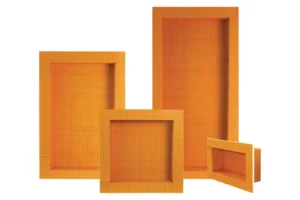
One of the most overlooked parts of shower niche planning is waterproofing. A poorly sealed niche can lead to leaks, mold, and expensive repairs down the road. Using a waterproofing system like Schluter Kerdi ensures water never penetrates behind the tile. This is especially important for custom tiled niches where grout lines are exposed to daily moisture.
Another key factor is slope — the bottom of the niche should be sloped slightly outward so water drains and doesn’t pool. Many homeowners don’t notice this detail, but it makes a big difference in preventing water damage and mold growth. Always confirm that your contractor is using a proper waterproofing system and building techniques that guarantee durability.
Design Aesthetics & Tile Layout
A shower niche isn’t just storage — it’s a design element. How you integrate it into your tile layout can make or break the look of your bathroom. Some homeowners choose to line the niche with the same tile as the shower walls for a subtle effect. Others go bold by using accent tiles, mosaic glass, or a contrasting color to make the niche pop.
Symmetry is another design choice. A centered niche draws the eye, while offset niches can complement unique layouts. If your bathroom has a double vanity or dual showerheads, consider mirroring two niches for balance. Planning your niche with your tile installer ensures grout lines, patterns, and edges align perfectly for a professional finish. For tile inspiration, see my guide on the best bathroom tile ideas.
Don’t Overdo It
One common mistake I see is homeowners trying to store everything in a single oversized niche. This can look bulky and out of place, especially in smaller bathrooms. Instead, consider installing two smaller niches for balance and symmetry. Couples often prefer this setup since each person gets their own storage space. It’s all about creating a balance between practicality and aesthetics so your shower doesn’t feel cluttered.
Cost and Budget Considerations
Like other bathroom remodel costs, niches vary in price depending on whether you choose custom or finished models. A finished stainless steel niche is often more affordable and faster to install. Custom tiled niches require more labor and waterproofing, which adds to cost, but they provide unlimited flexibility in design. When planning your bathroom renovation budget, think about how much storage you really need versus what will enhance the overall design.
Shower Niche FAQ
What is the standard shower niche height?
For a standing shower, the standard niche height is about 36 inches (waist level) from the base. In a tub-shower combo, niches are typically placed lower for easy reach when sitting.
How wide should a shower niche be?
Standard pre-made niches are usually 12×12 or 12×24 inches. If you use large pump bottles, a vertical 12×24 niche or larger is recommended to ensure everything fits comfortably.
Are stainless steel niches better than tiled niches?
Stainless steel niches are waterproof, durable, and maintenance-free, making them a reliable choice. Tiled niches can look elegant but require ongoing upkeep because grout and silicone can wear down over time.
Can I have more than one shower niche?
Yes, many homeowners install two smaller niches instead of one large one. This setup provides symmetry, more organized storage, and is especially popular for couples who want separate spaces.
Do shower niches leak?
If poorly built, custom tiled niches can eventually allow water to seep through grout and silicone. Finished stainless steel niches, on the other hand, are fully sealed and designed to be leak-proof.
Does a shower niche add value to a bathroom remodel?
Yes, a well-planned shower niche adds both function and style, making your bathroom feel more custom and practical. Buyers notice these details, which can boost resale appeal.
Can a niche be placed on any wall?
Not always. Niche placement depends on plumbing, exterior walls, and wall stud layout. Typically, the back or side walls of the shower work best, but your contractor can determine the ideal location.
How much does a shower niche cost to install?
A pre-made stainless steel niche can cost between $150–$300 plus labor, while a custom tiled niche often ranges from $400–$1,000 depending on size, materials, and waterproofing requirements.
Can I retrofit a niche into an existing shower?
Yes, but it’s more complex. Retrofitting requires cutting into existing tile and ensuring waterproofing is maintained. It’s best done during a full bathroom remodel to avoid leaks and hidden water damage.
What’s the best way to clean and maintain a tiled niche?
Regularly wipe down grout lines and reseal them every year or two to prevent staining and leaks. For stainless steel niches, simple soap and water is usually enough to keep them looking new.
Final Thoughts
Shower niches may seem like a small detail, but they play a huge role in how your bathroom looks and functions. The right size, style, and placement can transform your daily routine while keeping your shower clean and organized. Whether you choose a custom tiled design or a finished stainless steel option, planning carefully will ensure your niche lasts for years to come. If you’re ready to start planning your remodel, I’d be happy to guide you. Visit my bathroom renovation services page or contact me today to schedule a consultation.

